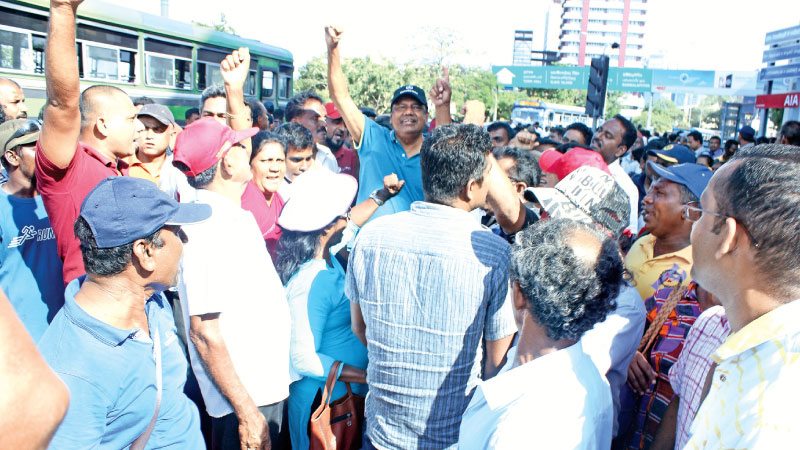Lunacy expressed by the so-called Janabala campaign of Mahinda group shows that they are still at the retrogressive political level showed in their downfall in 2015. They are unable to come out of the retrogressive parochial chauvinist framework that they have built for themselves when they had unlimited power. That process though political primitive, was with an anti-feminist, anti-rational, strong emotional impact. The downfall of Mahinda started and gathered momentum; with the impeachment of CJ, the first female Chief Justice Shirani Bandaranayke in January 2013.
The impeachment involved a dramatic set of events which stripped the judiciary of almost all its independence. In 2011 tensions between the Chief Justice and the executive reached its pinnacle when Shirani ruled that the Government’s desire to create a Divineguma (improving lives) required referral to the Provincial Councils for their assent. I was one of the signatories to the petition that went before CJ. At that time I was noted as an adversary of the Mahinda regime and a pro-devolution campaigner. This added to ignite a campaign vilifying the Chief Justice. They claimed that by upholding the thirteenth amendment, she was encouraging separatism, and consolidating the power of Provincial Councils; A powerful attack on fascistic politics.
Mahinda regime
All this went against the Mahinda regime threatened by any organ which dilutes its power and any part of the Constitution which can validate this dilution. On November 2012, members of the Governing United People’s Freedom Alliance (UPFA) provided the Speaker with a resolution accusing the Chief Justice of fourteen allegations of alleged misconduct signed by 177 members of Parliament. According to some accounts, ministers affirmed the impeachment despite being deprived of a chance to actually read the allegations that were made against Shirani.
On January 13, Mahinda delivered a proclamation removing Shirani from office. Two days later, Mohan Peiris, former Attorney General and at that time, a legal advisor to the Cabinet and to the Rajapaksa family was sworn in as Chief Justice. Promoting such people to the higher courts deliberately ensured that the judiciary will be subordinated to the ‘executive mindset.’ It demonstrated Mahinda’s desire to elect someone who would beckon to the power of the president, rather than question it.
This impeachment crisis further prolonged the trend towards unfettered and irregular exercise of executive power without any regard for due process, the judiciary and the Constitution. The independence of the judiciary was fundamentally undermined and its ability to act as a check on the executive and legislative branches was eradicated. In fact, the nature of which Parliamentary debate and voting for the impeachment motion occurred proved that like the judiciary, the legislature was also servile to the executive and ceased to act as a check on the executive.
As pundits articulate, the rules of the game were no longer separated from the game; in reality, constitutional structures were captured on Mahinda’s playing field. He removed the judiciary’s check on his power and consolidated a racist fascistic, authoritarian regime. These events illustrated Mahinda’s purposeful plan to remove institutional prerequisites of a democracy which exist as a counter to executive misuses. It is clear the impeachment of the Chief Justice completed the Constitutional Coup which had begun with the 18th Amendment.
Democratic institutions
The second portion of the fascistic intervention includes Mahinda’s more explicit actions to sweep out democratic institutions. Although these attacks are less legalistic and procedural, the first part of the narrative very much strengthened and bolstered the force of them. A significant operation that underpinned Mahinda’s reign was the centralization of power through family rule.
Rajapaksa offered powerful government positions to his family members, both immediate and distant to erode the checks on his power and to ensure that he faced minimal dissent. Basil, Gotabhaya and Namal Rajapaksa are just a few of the household family figures who arrogated power during this reign. Hence, encircled by his family Rajapaksa opened opportunities for corruption, abuse of power and bribery. For instance, the judiciary and the press were intimidated to act in ways that benefit the Rajapaksa family and therefore, were forced to be servile to their power.
Although nepotism has not widely been written about in the democratic decay framework, arrogating power in this way has a damaging effect on democracy. Such personalized governance allowed Mahinda to firstly concentrate power in the hands of his family, and then monopolize and entrench his own presidential power and to use it in the way he desired, with minimal resistance and transparency. The domination of this patronage system was also a large reason why there was little opposition in Parliament to the 18th amendment. The manipulation of practice already in place, acted as the facilitating framework to allow the passing of the amendment in parliament. In reverse, manipulations of practice were then given backing by the constitutional or legal methods to safeguard their existence and vitality.
The master-plan was, therefore, all-encompassing. Hence, it is clear that single parts of Mahinda’s were strengthened when they were executed together as they open greater opportunities to further weaken democracy. It ensured that the appearance of democracy was seen to be upheld as different portfolios and roles existed and were fulfilled, however, in reality, they were occupied by people that were constantly bolstering and protecting Mahinda’s power. In this way, Mahinda could use the superficial appearance of democracy and the backing of the electorate to minimize challenges to his rule and remove important accountability mechanisms of a democratic state.
What happened in the past should be a lesson we go through again, and again. Fascism comes with shouting for democracy and peoples power, which they crush in many ways as you could see in the short history of the Mahinda regime.



Add new comment